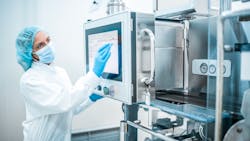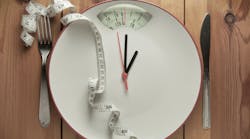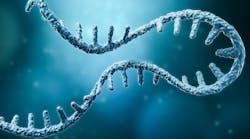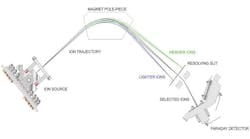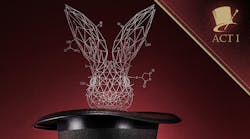In each and every lifesaving or life-sustaining medical application, it is imperative that the safety, quality and reliability of flow measurement functions are not compromised. This makes the early detection and prompt resolution of any flow measurement difficulties or abnormalities — such as inadequate blood flow, changes in flow rate or the presence of air in the transfer lines — that may occur during a critical medical procedure vitally important.
The same is true for the development and manufacture of biopharma drugs and therapeutics, especially in downstream applications that require flow measurement. This typically includes chromatography and tangential flow filtration (TFF) processes that are used to separate cells or proteins through the removal of unwanted components in a liquid stream. Downstream bioprocessing includes other steps, for example, inline buffer formulation, column packing and virus filtration.
Charged with supporting the precise operation of the flow measurement functions in these highly specific and challenging applications are flow measurement sensors, which have been designed to deliver high performance, reliability and accuracy when handling delicate, sensitive and demanding liquids. The sensors and corresponding devices for flow evaluation must also possess the capability to provide optimized data outputs for process control when used in applications that have strict hygienic manufacturing requirements.
There are numerous pain points that must be overcome in critical biopharma production operations, but new flow measurement options can be a first-choice solution for use over a wide range of process control conditions.
The pain points
As mentioned, achieving and maintaining consistent, reliable and accurate flow measurement is a front-of-mind concern in biopharma applications. What makes that difficult is the fact that there are many different operational variables that must be identified and controlled before the required level of flow measurement accuracy can be achieved. These variables can include liquid density, mass flow rate, volumetric flow rate, liquid temperature and pumping pressure.
To help standardize these procedures, some OEMs are beginning to develop and offer skid systems that are outfitted with all of the necessary components, from pumps and flow measurement sensors to compressors and dispensers. The difficulty here is identifying and utilizing components that are able to communicate with each other via analog or digital signals, with digital communication preferred today due to its superior speed and reliability over analog communication.
A particular circumstance to avoid during flow-measurement activities is the creation of cavitation in the liquid stream. Cavitation is defined as “the formation of (vapor) bubbles within a liquid.” These bubbles can form when the pressure exerted on the liquid becomes low enough that it starts to evaporate. As the bubbles move through the measurement section of the flow sensor, they can implode back into liquid form. The rapid collapse creates a shockwave of energy in the liquid that can compromise the flow rate and the liquid’s overall integrity.
In applications that require the transfer of cells in a liquid, cavitation can create all sorts of problems. In this instance, the operator should run the pump for a few seconds, stop it and then restart it. At this point, after the restarted pump has been running for a bit, it is possible to check if all vapor bubbles have been evacuated from the line. If no bubbles exist, the transfer process can be restarted with no concern that cavitation will occur.
The solution
The manufacturers of flow measurement sensors are familiar with the challenges that are inherent in achieving and maintaining proper flow measurement values in biopharma applications. Many have worked diligently to develop products — which can include flow measurement sensors, liquid-handling pumps, mixers and feed systems, dispensing equipment and flow meters — that can be bundled together to create a customized solution that is capable of handling the unique process conditions of individual applications.
In the flow measurement realm, single-use models are designed to deliver optimized flow measurement in critical applications. These flow measurement tools feature a disposable sensor that comes with an integrated straight flow path. Since it is designed to fit the operational parameters of the majority of biopharma applications, there is no need for individual calibration as the process moves from application to application.
Other features found in single-use sensor technology include:
- Reusable, easy-to-mount holders with integrated electronics and Power over Ethernet (PoE) capabilities
- Locking mechanism that enables tool-less attachment of the disposable sensor
- Standard ultrasonic technology that allows flow measurement and air-in-line detection with one sensor
- Standard connection point for easy integration into manifolds
- Straight-through flow path that imparts less shear stress on the liquid product
- Cableless connection between the sensor and electronic cap for better IP protection
- One holder that is compatible with all common sensor and tubing sizes
Other flow measurement sensor options include:
- Clamp-on sensors: This type of sensor supports the reliable measurement and monitoring of flow rates in applications within laboratory and industrial applications. It can feature a click-fastening sensor that can be quickly and easily attached to flexible tubes with a non-invasive measurement method that prevents additional shear stress from being imparted on the pumped liquid. This is a notable advantage over some flow measurement methods — like turbine flow meters — when it comes to handling shear-sensitive cells. These sensors can also feature an ultrasonic transit-time method of operation. Pairing that with customer-specific calibration in relation to the process’s liquid-handling parameters provides an accurate flow measurement.
- Single-use Coriolis flow sensors: This type of sensor is typically comprised of two assemblies: one that contains the single-use sensor and a second that contains the supporting electronics. These sensors can measure liquids in high-purity biopharma applications, as well as mass flow rate, total mass and temperature.
These sensors can communicate with other process control components via analog or digital communication protocols. In this case, a compatible digital signal can also read the flow measurement values instantaneously, which enables a quicker response to any operational problems or anomalies that might occur while also lessening the risk of human error.
Process conditions in biopharmaceutical processing/manufacturing applications can vary greatly, but they have this in common: their performance must be optimized so that the application can be completed successfully. This means that the components, including flow measurement sensors, must be able to help achieve and maintain the highest levels of safety, quality and reliability as they function in biopharma manufacturing.
